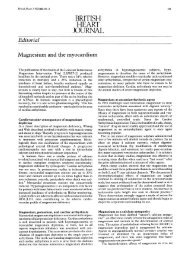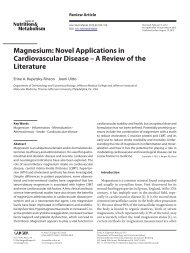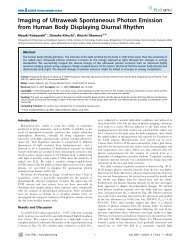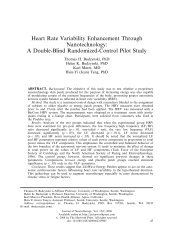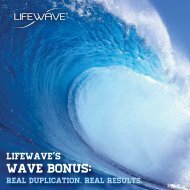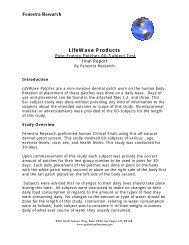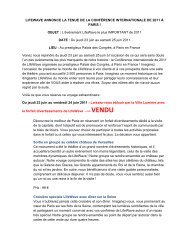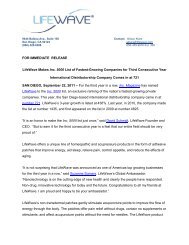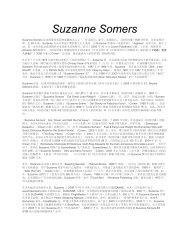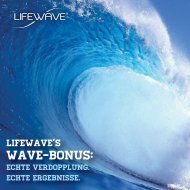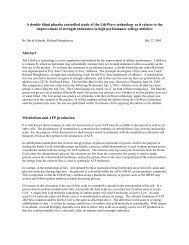Nanotechnology is a new technology that is based upon ... - LifeWave
Nanotechnology is a new technology that is based upon ... - LifeWave
Nanotechnology is a new technology that is based upon ... - LifeWave
Create successful ePaper yourself
Turn your PDF publications into a flip-book with our unique Google optimized e-Paper software.
1<br />
Different Types of <strong>Nano<strong>technology</strong></strong> Devices<br />
By: Steve Haltiwanger, M.D., C.C.N.<br />
<strong>Nano<strong>technology</strong></strong> <strong>is</strong> a <strong>new</strong> <strong>technology</strong> <strong>that</strong> <strong>is</strong> <strong>based</strong> <strong>upon</strong> recognized scientific principles<br />
and material science fabrication techniques where individual molecules and even atoms<br />
can be arranged into prec<strong>is</strong>e structures.<br />
“Nano means one billionth. <strong>Nano<strong>technology</strong></strong> <strong>is</strong> the study and design of systems at the<br />
nanometer scale - the scale of atoms and molecules.” (Exploring the Nano World.<br />
http://mrsec.w<strong>is</strong>c.edu/Edetc/index.html). Nanoscale technologies are the development<br />
and use of devices <strong>that</strong> have a size of only a few nanometers.<br />
<strong>LifeWave</strong> Overview<br />
The goal of <strong>LifeWave</strong> <strong>technology</strong> <strong>is</strong> to create a variety of patches using proprietary<br />
solutions of organic molecules as building blocks. The <strong>LifeWave</strong> Energy and Stamina<br />
Patches are compr<strong>is</strong>ed of solutions of optically active organic materials.<br />
These special solutions are placed in a reservoir between two pieces of plastic, which<br />
create a sealed chamber. Within the sealed reservoir <strong>is</strong> a piece of fabric <strong>that</strong> serves as a<br />
template for the self assembly of organic molecular antennas (nano-sized molecular<br />
structures) using solution-<strong>based</strong> self-assembly processes.<br />
Photoelectric dendrimeric branching light-harvesting molecular antennas have been<br />
designed and synthesized by a number of researchers. (Z. Xu, J.S. Moore, "Design<br />
and Synthes<strong>is</strong> of a Convergent and Directional Molecular Antenna," Acta Polymerica<br />
45(1994):83-87.; M.R. Shortreed, S.F. Swallen, Z.-Y. Shi, W. Tan, Z. Xu, C. Devadoss,<br />
J.S. Moore, R. Kopelman, "Directed Energy Transfer Funnels in Dendrimeric Antenna<br />
Supermolecules," J. Phys. Chem. 101(1997):6318-6322.; C. Devadoss, J.S. Moore,<br />
"Synthetic Light Harvesting Antennas," 1999 McGraw-Hill Yearbook of Science and<br />
Technology, Mcgraw-Hill, NY, 1999, pp. 284-287.)<br />
Photoelectric and Photovoltaic Devices<br />
By way of example, solar cells have been around for decades however one of the draw<br />
backs <strong>is</strong> <strong>that</strong> they don’t work well on cloudy days, because the older <strong>technology</strong> <strong>is</strong> <strong>based</strong><br />
on harnessing the energy of v<strong>is</strong>ible light. Now <strong>new</strong> <strong>technology</strong> <strong>based</strong> on plastic<br />
composite materials <strong>is</strong> being researched <strong>that</strong> can create solar cells <strong>that</strong> are able to harness<br />
the sun's inv<strong>is</strong>ible, infrared rays. National Geographic reported in January of 2005 <strong>that</strong><br />
scient<strong>is</strong>ts had combined nano particles called quantum dots with a polymer to make a<br />
plastic composite <strong>that</strong> can be sprayed onto other materials and used as portable electricity<br />
(Stefan Lovgren. Spray-On Solar-Power Cells Are True Breakthrough. National<br />
Geographic, January 14, 2005.)
2<br />
The point of d<strong>is</strong>cussing the nano<strong>technology</strong> aspect of th<strong>is</strong> plastic paint <strong>is</strong> <strong>that</strong> the plastic<br />
composite containing the quantum dots actually absorb the sun’s infrared energy and<br />
convert it to electricity.<br />
Other Examples of Using a Molecular Antenna to Harness Electromagnetic Energy<br />
Dr. Alvin Marks <strong>is</strong> a scient<strong>is</strong>t who has invented a solar cell on a plastic roll. “In 1994<br />
Advanced Research Development, Inc. (ARDI) of Athol, MA and DOE's Argonne<br />
National Lab entered into a cost-sharing cooperative arrangement for the further<br />
development of the Lumeloid (t.m. reg.) product. Th<strong>is</strong> light-to-electric concept <strong>is</strong> <strong>based</strong><br />
on replication of part of the photosynthes<strong>is</strong> process. The solar panel uses molecular<br />
diodes called "diads." The Lumeloid process includes the diads in a stretch-oriented<br />
electrically conductive polarized film. The polarizing molecules act as antennae to<br />
convert light photons to electric power. Efficiencies as high as 72% appear possible.<br />
The polarizing molecules act as antennas to convert light photons to electric power.<br />
Efficiencies as high as 72% appear possible (NEW ENERGY NEWS<br />
http://www.padrak.com/ine/INE9.html. Monthly Newsletter for the Institute for New<br />
Energy. VOLUME 3, NUMBER 5. ISSN 1075-0045, OCTOBER 1995).<br />
Other type of solar cells can be made <strong>that</strong> uses photosensitive dyes or even organic<br />
pigments extracted from raspberries. These devices can be manufactured in a high school<br />
chem<strong>is</strong>try lab and utilize nano materials. These devices demonstrate <strong>that</strong> some nanotech<br />
products can be manufactured by relatively simple techniques.<br />
A solar (photovoltaic) cell experimental educational kit has been developed using natural<br />
dyes extracted from berries. These photovoltaic kits use nanocrystalline dye-sensitized<br />
solar cells <strong>that</strong> use an organic dye to absorb incoming light to produce excited<br />
electrons (Nanocrystalline Dye-Sensitized Solar Cell Kit<br />
http://www.solideas.com/solrcell/cellkit.html).<br />
Here <strong>is</strong> an example of a device <strong>that</strong> uses nano-size crystals of titanium dioxide and<br />
organic materials. Th<strong>is</strong> device <strong>is</strong> sold as an educational science kit. Th<strong>is</strong> simple solar cell<br />
kit has been released by the American Chemical Society's Institute for Chemical<br />
Education to teach high school students about nano<strong>technology</strong>. Below <strong>is</strong> a description of<br />
the device <strong>that</strong> uses fruit juice as one component used to create molecular antennas.<br />
“To fabricate the <strong>new</strong> cell, a titanium dioxide film <strong>that</strong> <strong>is</strong> coated on a conductive glass<br />
plate <strong>is</strong> dipped into a solution of a dye (for example blackberry, raspberry, or<br />
pomegranate juice). A single layer of dye molecules self assembles on each titanium<br />
dioxide particle and absorbs sunlight. To complete the device, a drop of liquid electrolyte<br />
containing iodide (similar to medicinal iodide) <strong>is</strong> placed on the film to enter the pores of<br />
the film. A counter electrode, made of conductive glass <strong>that</strong> has been coated with a<br />
catalytic layer, <strong>is</strong> then placed on top, and the two glass plates are clipped together using<br />
binder clips (1. Greg Smestad. New Solar Cell Kit Links PV, Plants and the Planet<br />
http://www.solideas.com/solrcell/<strong>new</strong>s97.html); 2. Greg P. Smestad and Michael Grätzel,<br />
Demonstrating Electron Transfer and <strong>Nano<strong>technology</strong></strong>: A Natural Dye-Sensitized
3<br />
Nanocrystalline Energy Converter. Journal of Chemical Education, Vol. 75, pp 752-756,<br />
June 1998.)<br />
A number of review articles are included <strong>that</strong> elaborate more on dye sensitized solar<br />
cells and other optoelectronic applications <strong>based</strong> on nanocrystalline films.<br />
Reviews<br />
• K. Kalyanasundaram and M. Graetzel. Applications of Functionalized Transition Metal Complexes in<br />
Photonic and Optoelectronic devices. Coord. Chem. Rev., 77, 347-414 (1998).<br />
• T. Gerfin, M. Graetzel and L. Walder. Molecular and Supramolecular Surface Modification of<br />
Nanocrystalline TiO2 films: Charge-Separating and Charge-Injecting Devices.Progr. Inorg. Chem.,<br />
44, 345-393 (1997).<br />
• A. Hagfeldt and M. Graetzel. Light induced redox reactions in nanocrystalline systems. Chem.Rev.,<br />
95, 49-68 (1995).<br />
It <strong>is</strong> well recognized <strong>that</strong> the sun emits infrared radiation, however so do animals and the<br />
human body. It <strong>is</strong> called ‘body heat’. The concept of molecular antennas <strong>is</strong> <strong>based</strong> on the<br />
principle of using molecules to act as receivers or transmitters of high frequency<br />
electromagnetic energy.<br />
<strong>LifeWave</strong> patches are manufactured with natural materials to produce organic<br />
molecules <strong>that</strong> are nanometers in size. The production of small molecular antennas<br />
of nanoscale size <strong>is</strong> the nano<strong>technology</strong> aspect of th<strong>is</strong> <strong>technology</strong>. The fact <strong>that</strong> the<br />
production of <strong>LifeWave</strong> patches involves making a solution, using proprietary processing<br />
techniques and using a special piece of fabric to cause a precipitation out of solution of<br />
nano-sized molecular crystals does not in anyway detract from the fact <strong>that</strong> th<strong>is</strong> <strong>is</strong> a<br />
nano<strong>technology</strong> manufacturing technique.<br />
<strong>LifeWave</strong> patches are constructed of organic materials. These organic materials have<br />
been chosen because they have optical (chiral), liquid crystal and semiconductor<br />
properties. By using a nano<strong>technology</strong> production process called solution-<strong>based</strong> selfassembly<br />
these optically active and electrically conductive materials when placed in<br />
<strong>LifeWave</strong> patches form small nanosize molecular structures <strong>that</strong> function as molecular<br />
antennas. Placing a conducting material in an oscillating magnetic field creates an<br />
electrical signal/frequency in the conducting material.<br />
The "very small" molecules in the patches contain electromagnetic properties. These<br />
small nanoscale structures serve as passive molecular antennas <strong>that</strong> are activated by the<br />
oscillating electromagnetic field of the body to generate electromagnetic signals <strong>that</strong> are<br />
resonant frequencies for certain structures contained within mammalian cells. These<br />
frequencies are generated by the physics principle of INDUCTION.<br />
Next every element has a resonant frequency at which it will emit and absorb energy.<br />
When you combine various combinations of elements together into molecules you will<br />
find <strong>that</strong> every molecule and every material has its own resonant frequency. You can
4<br />
determine the molecular structure, molecular weight and size of various organic<br />
molecules such as enzymes in protein data bases on the World Wide Web and from th<strong>is</strong><br />
information use standard physics formulas to calculate the resonant frequency of a<br />
molecule.<br />
“Any object has a certain natural or resonant frequency… when two objects have similar<br />
natural frequencies, they can interact without touching, their vibrations can become<br />
coupled or entrained.” (Oschman, James L. Energy Medicine: The Scientific Bas<strong>is</strong>.<br />
London: Harcourt Publ<strong>is</strong>hers, 2000.)<br />
The mathematical formula for an antenna (length in meters or in th<strong>is</strong> case nanometers) <strong>is</strong><br />
well known. If you already know the frequency <strong>that</strong> you want to create the wavelength in<br />
meters or nanometers can be calculated. The proprietary process involved in<br />
manufacturing <strong>LifeWave</strong> patches involves the creation of nanometer sized molecular<br />
crystals in a nontransdermal patch. When the molecular crystals in the patches are<br />
exposed to the body's oscillating electromagnetic field signals are generated <strong>that</strong> are<br />
resonant with certain protein structures in membrane receptors. These structures are<br />
known to operate by a communication system called signal induction (usually a chemical<br />
signal, but it can also be a frequency signal) the activation of these receptors results in<br />
coupling and amplification of the signal in a process known as signal transduction.<br />
THE BASIC ISSUE IS THAT YOU CAN ACTIVATE METABOLIC REACTIONS<br />
WITH FREQUENCY SIGNALS AS WELL AS CHEMICAL SIGNALS, IF YOU<br />
HAVE THE PROPER FREQUENCY CODE AND WAVEFORM. <strong>LifeWave</strong> patches<br />
basic function <strong>is</strong> to generate a set of biologically active signals when the patches interact<br />
with the human body.<br />
Some Electronic Properties of Biological Molecules<br />
Enzymes and proteins are also semiconductors. Since enzymes and proteins in the cells<br />
organize into cooperative structures and contain components <strong>that</strong> are nanometer-sized,<br />
the length of wavelengths of energy these components will resonate to must also be<br />
nanometer in size.<br />
By definition a semiconductor <strong>is</strong> a solid crystalline substance, such as germanium or<br />
silicon or liquid crystalline substances, such as proteins, RNA or DNA <strong>that</strong> have<br />
electrical conductivity greater than insulators, but less than good conductors.<br />
Solid crystalline semiconductors are used especially as a base material for computer chips<br />
and other electronic devices. Whereas liquid crystal semiconductors like proteins and<br />
DNA are being investigated for use in organic electronic devices.<br />
It has been known since the time of Georges Lakhovsky, a Russian electrical engineer<br />
<strong>that</strong> even cells are electrical in nature. In h<strong>is</strong> book called The Secret of Life publ<strong>is</strong>hed in<br />
1935 he described how cells manifest the electrical properties of res<strong>is</strong>tance, capacitance,<br />
and inductance. In h<strong>is</strong> book he described how he could generate high frequency radio<br />
waves with an electronic device called a multiwave oscillator. He reported <strong>that</strong> he could
5<br />
energize malfunctioning cells, which had lower than normal stored electrical charges by<br />
exposing the body to electromagnetic energy. H<strong>is</strong> device produced a temporary increase<br />
of charge in the cell membranes in cells with low charge. (Th<strong>is</strong> <strong>is</strong> analogous to recharging<br />
a flashlight <strong>that</strong> uses a charged capacitor. A flashlight with a charged capacitor works<br />
better than a flashlight which has a d<strong>is</strong>charged capacitor.) When dysfunctional cells are<br />
energized, waste <strong>is</strong> expelled and nutrients will be ingested. Comparing Lakhovsky<br />
invention to <strong>LifeWave</strong> we find <strong>that</strong> both methods increase the energy of cells, however<br />
there are some differences. While Lakhovsky used an electrical device to send energy<br />
into the cells to give cells a temporary charge <strong>LifeWave</strong> patches send information signals<br />
into the cells <strong>that</strong> cause the cells to produce more energy producing a more sustained<br />
effect.<br />
Capacitance <strong>is</strong> an electrical property, which <strong>is</strong> the ability to accumulate and store charge<br />
from a circuit and later give it back to the circuit.<br />
Chiral or Optical Isomers<br />
"Some chemical compounds have optical activity in the sense <strong>that</strong> these compounds have<br />
the ability to rotate the plane of polarized light. Polarized light has light waves all<br />
traveling parallel to each other. Ordinary light has light waves traveling in all directions.<br />
When polarized light <strong>is</strong> passed through a solution of an optically active compound, the<br />
plane of polarization <strong>is</strong> rotated to the right or the left. The angle of rotation can be<br />
measured in a polarimeter<br />
(http://www.elmhurst.edu/~chm/vchembook/209optical.html).”<br />
Faraday's Law of Induction<br />
"In physics, a quantitative relationship between a changing magnetic field and the electric<br />
field created by the change, developed on the bas<strong>is</strong> of experimental observations made in<br />
1831 by the Engl<strong>is</strong>h scient<strong>is</strong>t Michael Faraday. The phenomenon called electromagnetic<br />
induction was first noticed and investigated by Faraday; the law of induction <strong>is</strong> its<br />
quantitative expression. Faraday d<strong>is</strong>covered <strong>that</strong>, whenever the magnetic field about an<br />
electromagnet was made to grow and collapse by closing and opening the electric circuit<br />
of which it was a part, an electric current could be detected in a separate conductor<br />
nearby. Moving a permanent magnet into and out of a coil of wire also induced a<br />
current in the wire while the magnet was in motion. Moving a conductor near a<br />
stationary permanent magnet caused a current to flow in the wire, too, as long as it was<br />
moving (ENCYCLOPEDIA BRITANNICA).” The phenomenon of induction <strong>is</strong> used in<br />
<strong>LifeWave</strong> by putting the conducting materials in the patches in the body’s moving<br />
(oscillating) magnetic field.<br />
Summary Statement<br />
<strong>LifeWave</strong> non-transdermal patches are constructed from organic materials like amino<br />
acids, sugars and stabilized oxygen (all GRAS l<strong>is</strong>ted), <strong>that</strong> are sealed inside a polymer<br />
shell (the Hardware). The materials in the patches form molecule sized liquid crystal
6<br />
structures <strong>that</strong> are very small antennas. These molecular antennas are activated by the<br />
body's energy field to create specific signals <strong>that</strong> are carried into the body and cause the<br />
cells to increase energy production from fat. In a sense patches are programmed like<br />
computer chips (the Software) by using different formulas <strong>that</strong> will produce different<br />
sized antennas and different biological messages.<br />
The Patches are completely non-transdermal, no substance enters the body. Th<strong>is</strong> has been<br />
proven by independent laboratory verification with electron micrographs and studies<br />
where the patches were heated to 40 degrees C and placed in a vacuum. These studies<br />
have shown <strong>that</strong> the materials inside the patches do not leave the patches.



